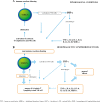Perforin: an important player in immune response
- PMID: 26155110
- PMCID: PMC4439970
- DOI: 10.5114/ceji.2014.42135
Perforin: an important player in immune response
Abstract
Perforin is a glycoprotein responsible for pore formation in cell membranes of target cells. Perforin is able to polymerize and form a channel in target cell membrane. Many research groups focus on the role of perforin in various diseases, immune response to bacterial and viral infections, immune surveillance and immunopathology. In addition, perforin is involved in the pathogenesis of autoimmune diseases and allogeneic transplant rejection. Natural killer (NK) cells and CD8-positive T-cells are the main source of perforin. However, CD4-positive T-cells are also able to express a low amount of perforin, when classic cytotoxicity is ineffective or disturbed. Polymerized perforin molecules form channels enabling free, non-selective, passive transport of ions, water, small-molecule substances and enzymes. In consequence, the channels disrupt protective barrier of cell membrane and destroy integrity of the target cell. This review will focus on mechanisms of action and structure of perforin. Also, in this review we discuss the problem of abnormal perforin production in diseases such as: hemophagocytic lymphohistiocytosis (HLH), leukemias and lymphomas, infectious diseases and autoimmune diseases. Better understanding of the role of these molecules in health and disease will open a new field of research with possible therapeutic implications.
Keywords: HLH; Hashimoto's disease; SLE; autoimmune diseases; cytolytic granules; granzyme; type 1 diabetes.
Figures




Similar articles
-
Natural killer cell dysfunction is a distinguishing feature of systemic onset juvenile rheumatoid arthritis and macrophage activation syndrome.Arthritis Res Ther. 2005;7(1):R30-7. doi: 10.1186/ar1453. Epub 2004 Nov 10. Arthritis Res Ther. 2005. PMID: 15642140 Free PMC article.
-
CD56+ putative natural killer cell lymphomas: production of cytolytic effectors and related proteins mediating tumor cell apoptosis?Hum Pathol. 1997 Nov;28(11):1276-82. doi: 10.1016/s0046-8177(97)90201-x. Hum Pathol. 1997. PMID: 9385933
-
Immunologic difference between hypersensitivity to mosquito bite and hemophagocytic lymphohistiocytosis associated with Epstein-Barr virus infection.PLoS One. 2013 Oct 18;8(10):e76711. doi: 10.1371/journal.pone.0076711. eCollection 2013. PLoS One. 2013. PMID: 24204658 Free PMC article.
-
Hemophagocytic lymphohistiocytosis: when the immune system runs amok.Klin Padiatr. 2009 Sep;221(5):278-85. doi: 10.1055/s-0029-1237386. Epub 2009 Aug 25. Klin Padiatr. 2009. PMID: 19707989 Review.
-
Molecular mechanisms of lymphocyte-mediated cytotoxicity and their role in immunological protection and pathogenesis in vivo.Annu Rev Immunol. 1996;14:207-32. doi: 10.1146/annurev.immunol.14.1.207. Annu Rev Immunol. 1996. PMID: 8717513 Review.
Cited by
-
The Spectrum of CAR Cellular Effectors: Modes of Action in Anti-Tumor Immunity.Cancers (Basel). 2024 Jul 22;16(14):2608. doi: 10.3390/cancers16142608. Cancers (Basel). 2024. PMID: 39061247 Free PMC article. Review.
-
Using Expanded Natural Killer Cells as Therapy for Invasive Aspergillosis.J Fungi (Basel). 2020 Oct 17;6(4):231. doi: 10.3390/jof6040231. J Fungi (Basel). 2020. PMID: 33080826 Free PMC article.
-
Cancer immunoediting hypothesis: history, clinical implications and controversies.Cent Eur J Immunol. 2022;47(2):168-174. doi: 10.5114/ceji.2022.117376. Epub 2022 Jun 30. Cent Eur J Immunol. 2022. PMID: 36751395 Free PMC article. Review.
-
Natural Killer Cells: Development, Maturation, and Clinical Utilization.Front Immunol. 2018 Aug 13;9:1869. doi: 10.3389/fimmu.2018.01869. eCollection 2018. Front Immunol. 2018. PMID: 30150991 Free PMC article. Review.
-
Ketogenic Diet and Ketone Bodies as Clinical Support for the Treatment of SARS-CoV-2-Review of the Evidence.Viruses. 2023 May 27;15(6):1262. doi: 10.3390/v15061262. Viruses. 2023. PMID: 37376562 Free PMC article. Review.
References
-
- Lichtenheld MG, Olsen KJ, Lu P, et al. Structure and function of human perforin. Nature. 1988;335:448–451. - PubMed
-
- Law RH, Lukoyanova N, Voskoboinik I, et al. The structural basis for membrane binding and pore formation by lymphocyte perforin. Nature. 2010;468:447–451. - PubMed
-
- Voskoboinik I, Dunstone MA, Baran K, et al. Perforin: structure, function, and role in human immunopathology. Immunol Rev. 2010;235:35–54. - PubMed
-
- Williams NS, Engelhard VH. Perforin-dependent cytotoxic activity and lymphokine secretion by CD4+ T cells are regulated by CD8+ T cells. J Immunol. 1997;159:2091–2099. - PubMed
-
- van den Broek MF, Hengartner H. The role of perforin in infections and tumour surveillance. Exp Physiol. 2000;85:681–685. - PubMed
Publication types
LinkOut - more resources
Full Text Sources
Other Literature Sources
Research Materials
